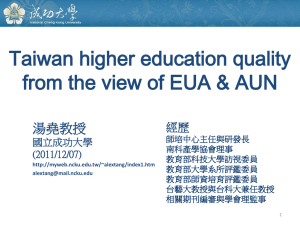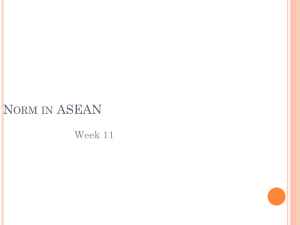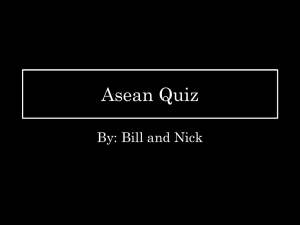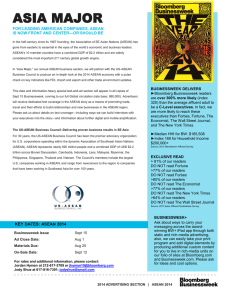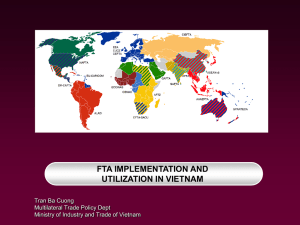VIETNAM
advertisement
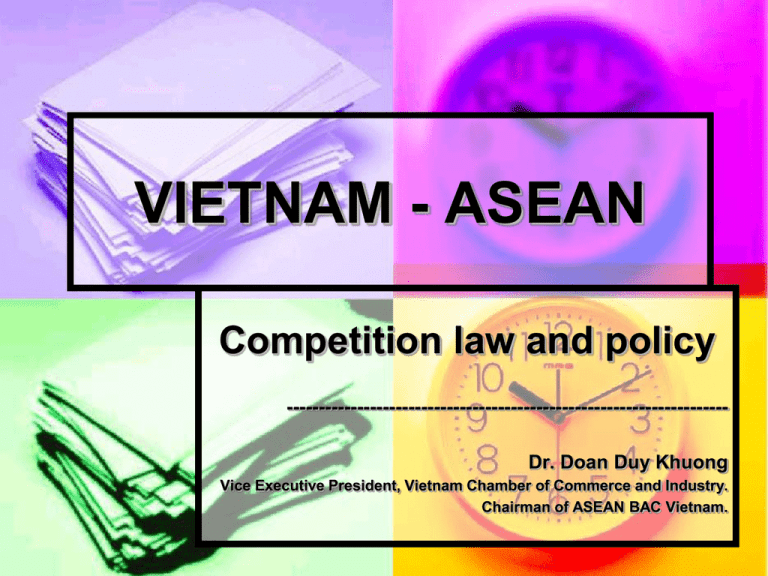
VIETNAM - ASEAN Competition law and policy --------------------------------------------------------------------Dr. Doan Duy Khuong Vice Executive President, Vietnam Chamber of Commerce and Industry. Chairman of ASEAN BAC Vietnam. 1. The World change 5 Cs Changes Global Competition IT Society Scien. Tech. Progress Challenges Chances Incr.Speed of Change New Products New Markets New Networks Incr. Competition Incr. Uncertainty Cooperation Competition 2. Vietnam vision 2020 GDP: 180 – 200 billion USD Population: More than 100 million Urban population: 50% Business: More than 2 millions (95%-97% SME) GDP Structure 2020 10.00% 46.00% 44.00% Agri., Forestry, Fishery Services Industry & Construction 3. Competition and SME in Vietnam 1. 2. 3. Contract farming Agriculture is a main economic sector 1981: household entered into contracts with cooperatives (collective production removed) 1986: “open economy” policy introduced 4. Contract farming is profitable for farmers, collectives and companies. 5. Contract farming has opened the new economic renovation process of Vietnam of the cooperation and competition 3. Competition and SME in Vietnam Moving from the centrally planned economy to socialist market economy since 1986 In the open economy, competition has become a driving force of the economy Development of private business sector and FDI increasing the competition level as well as causing unfair competition 3. Competition and SME in Vietnam SME in Vietnam: ~ 600.000 companies, and ~ 97% is SME and they are a backbone of the economy (GDP, employment & personal income) SME: an enterprise having a registered capital of no more than 10 bn VND or employing on average no more than 300 employees in a year 3. Competition and SME in Vietnam A new competition law has come into effect since July, 2005. It regulates unhealthy competitive practices (unethical practices as falsifying product information, infringing business secrets, coercing or defaming another enterprise, using misleading advertisements and promotions, discriminating within an industry association, engaging in illegal multilevel selling of goods…) and practices in restraint of competition by all businesses in Vietnam (practices that reduce, distort or hinder competition in the market such as agreements in restraint of competition, abuse of dominant market position and monopoly position, and economic concentrations – M&A…) 4. Competition and ASEAN ASEAN Economic Community (AEC) by 2015, AEC Blueprint ASEAN Summit 2011 “ASEAN Community in the Global Community of Nations” ASEAN vision beyond 2015 for broader roles of ASEAN Investment, service, transportation and tourism: ACIA, ATIGA, AFAS, MRAs, ASTP, ATSP Food, Energy and water security: APAEC, ASEAN integrated Food Security Framework, ASEAN plus Three Emergency Rice Reserve (APTERR) Equitable Economic Development: Initiative for ASEAN Integration (IAI), Master Plan on SMEs Development and SMEs Advisory Board (2011) 4. Competition and ASEAN Macroeconomic coordination and financial cooperation: CMIM (120 bn USD), ASEAN Plus Three Macro Economic Regional Surveillance Office (AMRO) ASEAN connectivity: Master Plan ASEAN connectivity (MPAC), ABTC Competition can drive ASEAN forwards. on However, “Unity in Diversity” Development gap; ASEAN survey on ASEAN’s competitiveness for trade and investment: SMEs accounts for 96% of all enterprises in ASEAN and the most vulnerable; ATIC 5. Conclusion There is a great deal of work ahead of us to achieve AEC by 2015. Cooperation and Competition are driving forces Competition policy is in need and can make things change positively (for all businesses) Strong political will


